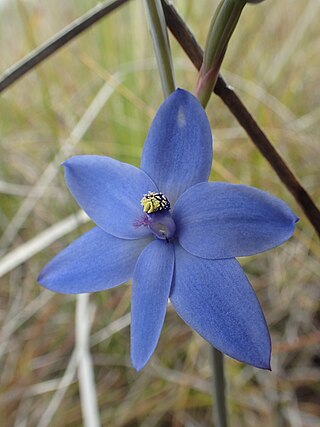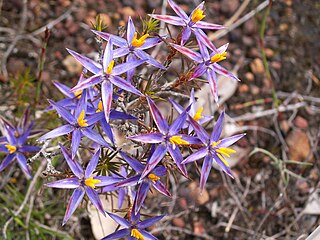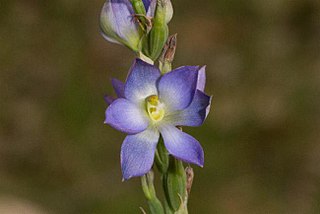
Darwinia, sometimes commonly known as mountain bells or simply bells, is a genus of about 70 species of evergreen shrubs in the family Myrtaceae, endemic to southeastern and southwestern Australia. The majority are native to southern Western Australia, but a few species occur in South Australia, New South Wales and Victoria. The genus was named in honour of Erasmus Darwin, grandfather of Charles Darwin by Edward Rudge in 1816. Most darwinias grow to a height of between 0.2 and 3 m, and many are prostrate shrubs. Most have small, simple leaves and the flowers are often grouped together, each flower with five red, white or greenish petals and ten stamens. In many species, the flowers are surrounded by large, colourful bracts, giving rise to their common names.

Thelymitra, commonly known as sun orchids, is a genus of more than 100 species of plants in the orchid family, Orchidaceae. Unlike most other orchids, sun orchids lack a highly modified labellum and all three petals are similar in size, shape and colour. The column is, however, highly modified and usually has prominent wings or glands which are helpful in identifying the species. Most sun orchids close their flowers at night, in cloudy or cool weather, giving rise to their common name. The scientific name means "woman's hood" and refers to the hooded column present in most, but not all species. Most species are endemic to Australia although some are found as far from there as the Philippines and Indonesia. The type species, Thelymitra longifolia, the first to be formally described, was collected in New Zealand.

Lechenaultia is a genus of flowering plants in the family Goodeniaceae, the species native to Australia with one species also occurring in New Guinea. Plants in the genus Lechenaultia are glabrous shrubs or herbs with needle-shaped leaves, more or less sessile flowers with five sepals and five blue, white, or yellow and red petals in two unequal lobes, the fruit an elongated capsule.

Bossiaea is a genus of about 78 species of flowering plants in the pea family Fabaceae and is endemic to Australia. Plants in this genus often have stems and branches modified as cladodes, simple, often much reduced leaves, flowers with the upper two sepal lobes larger than the lower three, usually orange to yellow petals with reddish markings, and the fruit a more or less flattened pod.

Thelymitra crinita, commonly known as the blue lady orchid, queen orchid or lily orchid, is a species of orchid which is endemic to the south-west of Western Australia. It has a single broad, oval leaf and up to fifteen brilliant blue flowers with a blue column with the lobe on top of the anther covered with short, finger-like calli.

Laxmannia is a genus of tufted perennial herbs in the family Asparagaceae, subfamily Lomandroideae, that are endemic to Australia.

Calectasia intermedia, commonly known as blue tinsel-lily or eastern tinsel lily is a species of flowering plant in the family Dasypogonaceae, endemic to the border areas of western Victoria and south-eastern South Australia and flowering in early spring. It is the only member of the genus Calectasia that is not endemic to Western Australia.

Calectasia grandiflora, commonly known as the blue tinsel lily, is a plant in the family Dasypogonaceae growing as a perennial herb endemic to the south-west of Western Australia. It flowers in spring.

Calectasia cyanea, commonly known as the star of Bethlehem or blue tinsel lily, is a plant in the family Dasypogonaceae growing as a perennial herb and is endemic to the south–west of Western Australia. Restricted to a single population in Torndirrup National Park, it is critically endangered.
Calectasia browneana, commonly known as blue tinsel lily, is a plant in the family Dasypogonaceae growing as a spreading, perennial, tufted herb. It is an uncommon species, endemic and restricted to a few areas in the south-west of Western Australia. It is similar to the other species of Calectasia and has only been recognised as a separate species since a review of the genus in 2001. It is distinguished from the others mainly by the hairiness of its leaves and lack of a rhizome.

Calectasia gracilis, commonly known as blue tinsel lily, is a plant in the family Dasypogonaceae and is endemic to the south-west of Western Australia. It is a spreading, tufted, woody, perennial herb with blue petals and six yellow stamens that turn orange-red as they age. It is similar to the other species of Calectasia and has only been recognised as a separate species since a review of the genus in 2001.

Calectasia hispida, commonly known as blue tinsel lily or hispid tinsel lily, is a plant in the family Dasypogonaceae growing as a rhizomatous, erect, clumping perennial herb. It is endemic to the south-west of Western Australia and is common in most of its range. It is similar to the other species of Calectasia and is distinguished from them mainly by the hairiness of its leaves and the glabrousness of the throat of the flowers.
Calectasia keigheryi, commonly known as blue tinsel lily, is a plant in the family Dasypogonaceae growing as an erect, rhizomatous, perennial herb. It is an uncommon species, endemic and restricted to a few areas in the south-west of Western Australia. It is similar to the other species of Calectasia and has only been recognised as a separate species since a review of the genus in 2001. It is relatively easily distinguished from the others mainly by its smaller flowers, unusual anther shape, and hairs on the lower part of the petals.

Calectasia narragara, commonly known as a blue tinsel lily or star of Bethlehem, is a plant in the family Dasypogonaceae growing as a tufted rhizomatous herb. It is endemic to the south-west of Western Australia and common in most of its range.
Calectasia pignattiana, commonly known as the stilted tinsel lily or Pignatti's star of Bethlehem, is a plant in the family Dasypogonaceae growing as a perennial herb and is endemic to the south–west of Western Australia. It is only known from ten locations, four of which are on road verges. The species is classified as vulnerable.
Calectasia obtusa, commonly known as a blue tinsel lily or blunt-leaved tinsel lily is a plant in the family Dasypogonaceae growing as an erect, small shrub with stems to 50 cm. It is endemic to the south-west of Western Australia, widespread in most of its range but only known from nine populations.
Calectasia palustris, commonly known as a blue tinsel lily or swamp tinsel lily is a plant in the family Dasypogonaceae growing as a perennial, tufted herb with stilt roots. It is an uncommon species, endemic and restricted to a few areas in the south-west of Western Australia. It is similar to the other species of Calectasia and has only been recognised as a separate species since a review of the genus in 2001.
Calectasia elegans, the elegant tinsel lily, is a species of flowering plants in the family Dasypogonaceae. It is found in Western Australia.

Thelymitra grandiflora, commonly called the giant sun orchid, is a species of orchid that is endemic to South Australia. It has a single large, erect, linear to lance-shaped leaf and up to forty large, dark metallic to greenish blue flowers with darker veins.
Thelymitra cornicina, commonly called the lilac sun orchid, is a species of orchid in the family Orchidaceae and is endemic to the south-west of Western Australia. It has a single narrow, pale green leaf and up to eight lilac-tinged blue flowers with the lobe on top of the anther covered with short, finger-like calli.














